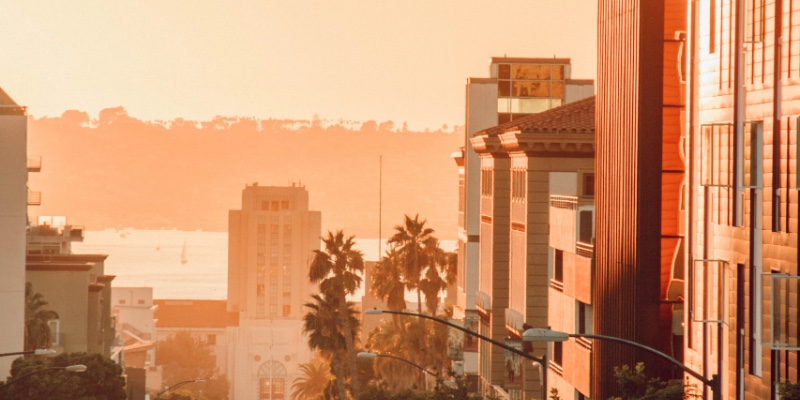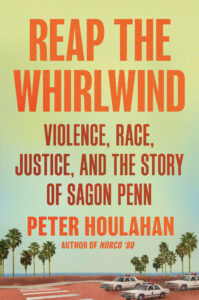In 1917, the seventy thousand residents of San Diego had a decision to make: “Smokestacks versus Geraniums.” Few cities have the chance to define their future, but the candidates in the 1917 election for mayor made the two possibilities clear. Gilded Age bankertype Louis J. Wilde—for whom no industrial project was too big to finance—marketed himself as “The Smokestack Candidate,” promising good jobs and good wages through the development of the city’s deepwater harbor into a center for shipping and manufacturing. Department store owner “Geranium George” Marston—champion of Balboa Park and organizer of the wildly successful 1915 Panama-California Exposition—saw the city’s welcoming climate and natural beauty as its greatest assets, promising a prosperous future in real estate and tourism through beautification and carefully managed growth.
Wilde had money and charisma, and he won the election with the backing of labor unions and business but soon got into a scandal, fled to Los Angeles, and died. Marston stuck around, lived to age ninety-five, and, through persistence and persuasion, brought the rest of San Diego around to his vision for their future. Geraniums it would be.
San Diegans never regretted their chosen path. With the well-established United States Navy anchoring the local economy alongside their Pacific fleet, and a post–World War II housing market flooded with VA-loan-eligible buyers, the residential real estate developers became the power brokers of the city. The tourism and hospitality industries loved the place, leveraging the white sand beaches, ocean sunsets, pleasant-year-round climate, and a rollicking Mexican border town that had become a tourist attraction itself into a major vacation destination. The city adjusted its zoning laws and dedicated its resources accordingly.
By 1985, the population of the greater San Diego metropolitan area had topped two million and moved onto the list of the ten most populous in the country. But San Diegans simply refused to believe it. In their minds, they were still a beach town, all fun in the sun, blue skies, and perfect waves, with a steady stream of tourists eager to spend their money to be there, even if only for a few days. “America’s Finest City” was what they called the place to outsiders, but among themselves they had a different slogan: “We are not L.A.”
Los Angeles, one hundred miles to the north, was increasingly plagued with murderous street gangs, guns, violent crime, and hard drugs. San Diego had none of these, right? They even elected a mayor in 1983 on a promise to stop the “L.A.-ification” of their city, and so far, it looked like the guy was living up to his campaign slogan. At least as far as they could see. But that was only because they were not looking in the right place.
***
When San Diego chose geraniums, the railroad tracks and freight trains that hauled products and raw materials across the country turned north, destined for the smokestacks and deepwater commercial port of Los Angeles instead. With them went the industrial and manufacturing demand for unskilled and low-skilled labor that attracted so many Black workers from the southern states and northeastern urban centers. The result was that the Black community in San Diego remained the smallest and least politically powerful among those of any major American city. As the rest of the city grew, the usual forces conspired to segregate and concentrate the Black population into a single area of the city, the Southeast, where it was guaranteed to be neglected and underserved.
The federal Home Owners’ Loan Corporation redlined the entire area of Southeast San Diego into the lowest Grade D-4 rating, recommending that mortgage lenders “refuse to make loans in these areas or only on a conservative basis,” due to “detrimental influences and an undesirable population or an infiltration of it.” With mortgages all but impossible to obtain, the community was denied home ownership and the accumulation of intergenerational wealth that went with it. The construction of elevated freeways carved up neighborhoods and commercial districts and allowed San Diegans to pass through the Southeast without ever knowing it was there. Suburban mega-malls doomed local retailers, and a 1978 statewide taxpayer revolt starved the area of the bonds and tax measures needed to maintain existing infrastructure and fund area improvements.
Southeast San Diego nevertheless developed into a vibrant, culturally rich, socially active community with strong religious and civic organizations. But it remained economically disadvantaged and vulnerable. By 1985, PCP, crystal meth, and crack cocaine had joined heroin in ruining lives, spiking burglaries and robberies by addicts, and flooding the area with guns. Street gangs became bigger, bolder, meaner, and more heavily armed as meaningless turf wars over the color of a bandana became open warfare for control of lucrative street corner drug markets. As things got progressively worse, the residents and community leaders of Southeast San Diego seemed unable to get the rest of San Diego to recognize it had become a big city with big-city problems.
That is, until March 31, 1985, when two white San Diego Police officers followed a pickup truck with seven young Black men up a long dirt driveway in the Southeast neighborhood of Encanto. Minutes later, something terrible happened.
***
The sound of a terrified woman’s voice coming over the San Diego Police Department radio frequency was chilling: “We need help. We need help.” Police racing through the streets in response to the desperate cry for help barely took notice of the police cruiser that passed them going the opposite direction, its light bar whirling blue and red. Behind the wheel, a police revolver on the seat beside him, was a twenty-three-year-old named Sagon Penn.
In the aftermath of the horrifying incident, the city of San Diego was left wondering how a police force considered one of the most progressive in the country when it came to issues of race and use of force could see two of its rising stars pull over a truck full of innocent young men on their way back from a day at the park, and still have everything go so terribly wrong. Sagon Penn, a soft-spoken and idealistic young man who believed his Buddhist chants could bring about the oneness of humanity, never disputed the violent events that occurred on that driveway in Encanto. San Diego was left to decide: Was there anything that could possibly justify such an act? For the city’s older, white establishment with their deep military traditions and rigid ideas of law and order, there could be no conceivable justification. But the Black community, numbering less than 7 percent of the population, had no trouble conceiving of such a scenario.
***
Had the story of Sagon Penn happened today, it would be a national media sensation, transfixing and dividing the country with its shocking developments and riveting courtroom drama. But in 1985, San Diego, California, was still young enough not to have discovered a national obsession with true crime, and it did not yet have access to the internet and twenty-four-hour news channels to deliver stories of crime and punishment into every home at all hours of the day. Nor had the majority-white population awoken to the historically difficult relationship between the Black community and the authorities charged with policing them.
For over two years, the city was forced to confront these uncomfortable truths about itself as it struggled with the realization that America’s Finest City had always been two cities living separate lives.
___________________________________


















